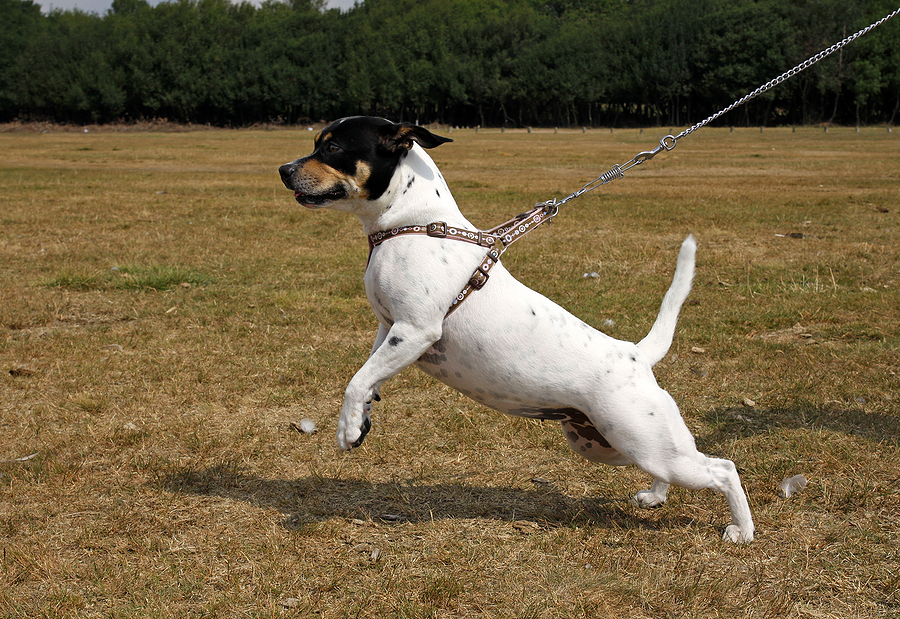Triggers are sensory reminders that cause painful memories or certain symptoms to resurface. These can occur through sight, sound, smell or touch.
According to PsychCentral, apart from trauma, the term “trigger” can be anything that activates or worsens the symptoms of mental health conditions, such as compulsive disorders.
When we experience trauma, our brains tend to store the surrounding sensory stimuli to memory. Then, when we encounter these sensory triggers again, the brain may reactivate the feelings associated with the trauma.
Trauma dogs experience will often create triggers. Car accidents, injuries, isolation, loss of a secure attachment and not feeling safe can all create different triggers.
One of the most common trigger for dogs is other dogs on leash. Often, this starts out as excitement but can turn into fear and anxiety.
Let’s use Pat the Poodle as an example. Pat is only six months old when he’s out walking with his dad, Dougie. Pat is having a great time sniffing the flowers and finding objects to pee on, while dad is telling him what a good boy he is. But when Pat sees a Shepherd named Sally he immediately gets overly excited. With this excitement, Dougie tightens the leash, yanks Pat back and tells him to “stop” in a voice that Pat hasn’t heard before. Pat feels scared because his secure attachment is interacting with him in this way. Pat doesn’t get to see Sally, and instead his dad pulls him away from all the fun they were having.
Imagine this happening every other time Dougie takes Pat out to walk. Over time, Pat will develop a trigger due to trauma he felt when dad changed his behavior so drastically towards him. The trigger, Sally the Shepherd, will eventually represent every dog Pat encounters. Now, when Pat sees a dog, he immediately begins to feel stressed due to the cortisol that is being released in his brain. Once cortisol is released, it will take time to run its course, which depends on your dog’s resilience.
If this pattern of stress stays consistent for Pat, triggers will begin to evolve to events, objects or locations Pat associates with other dogs. Pat will know that the potential of a trigger is high based on history, therefore, cortisol can begin to be released before Pat ever sees another dog on a walk.
Let’s look at potential triggers in this situation.
- Walking in the area where triggers have been consistent.
- Putting on the leash/collar/harness that Pat wears when seeing a trigger.
- The combination of leash and dad.
If this trend continues, due to the increase in cortisol, Pat will be unable to learn appropriate behavior in situations or around objects and people. Pat will also be more likely to react to common situations or people due to the anxiety he feels when out on a walk.
Avoiding reactivity is the best way to ensure your dog doesn’t suffer from this common behavior problem. Set your dog up for success by teaching them impulse control, response to functioning commands, and how to behave to get what they want. In Pat’s case, he just wanted to meet Sally.
We recommend that you ask a friend and their dog to assist you in teaching appropriate behavior for greeting. Let’s call this friend, Roscoe the Rottweiler. Roscoe’s mom, Myrtle will also be an integral part of this teaching. If doing this with a dog is too much for your pup, start with just a person or even an object such as their favorite tree.
- Roscoe and Myrtle will be set up in a stationary position.
- Pat and Dougie will be at a distance where Pat sees Roscoe but doesn’t react.
- Dougie will tell Pat how amazing he is just watching Roscoe and he may even give him some yummy treats. This is also a great time for Dougie to do the up/down pattern game with Pat.
- When Pat gives attention to anything other than Roscoe and shows self-control, Dougie will decrease the distance to Roscoe, but only by a few steps.
- This is repeated until Pat is unable to contain his excitement. At this point, Dougie remains at the distance where Pat can exhibit self-control, and then he will give Pat permission to see Roscoe. At this point, Pat is released.
Your lesson is two-fold. We want Pat to learn what behavior is needed to get permission to “greet” and we want Pat to learn what “greet” means, which is permission to approach. Once permission is given, Pat is either released from the leash or dad runs with him to say hi. Over time, Dougie will attempt to get Pat closer to Roscoe before permission is granted.
If you don’t have a friend to assist you, you can use the outside of a dog park. The dogs inside the park are the goal and permission can be given to approach the fence.
If your dog is exhibiting leash reactivity due to fear or anxiety, reach out to us and let us get you on the track to confidence, control, and resilience.
